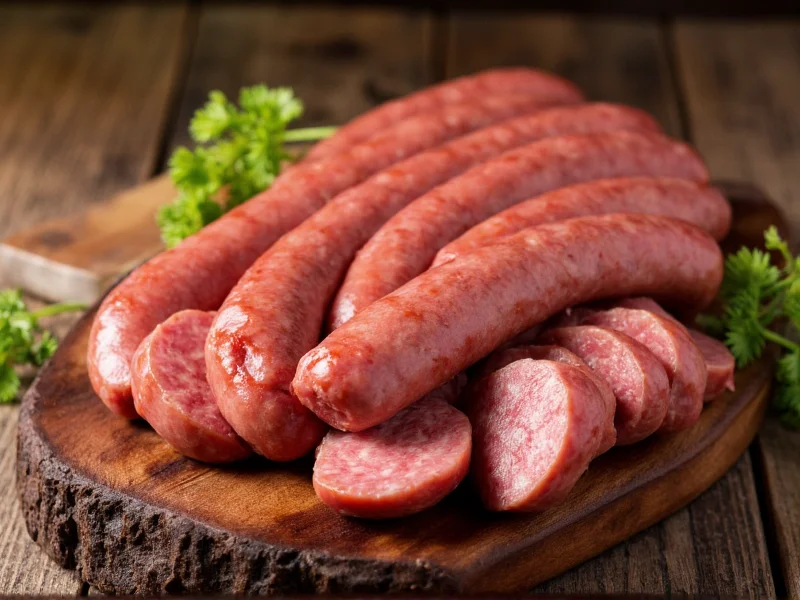Understanding Beef Sausage Varieties Worldwide
Beef sausage manifests in diverse forms across culinary traditions. While pork remains the dominant sausage meat in Europe and North America, beef sausage holds significant cultural importance in many regions where religious or cultural practices restrict pork consumption.
| Regional Variety | Key Characteristics | Distinct Ingredients |
|---|---|---|
| South African Boerewors | Coiled shape, coarse grind | Vinegar, coriander, nutmeg |
| Middle Eastern Kofta | Spiced meat on skewers | Parsley, mint, allspice |
| Mexican Longaniza | Thin, highly seasoned | Chili peppers, vinegar |
| Indian Nargisi Kofta | Meatball with egg center | Garam masala, ginger |
Composition and Quality Indicators
When evaluating premium beef sausage, examine the ingredient list for minimal processing. The best beef sausage recipes maintain a 70:30 lean-to-fat ratio for optimal juiciness without excessive greasiness. Natural casings from sheep or hog intestines provide superior texture compared to synthetic alternatives.
Quality beef sausage avoids:
- More than 15% fillers like breadcrumbs or soy protein
- Artificial preservatives such as sodium nitrite in excess
- Unidentified meat sources or "mechanically separated" ingredients
- Excessive sodium content (over 500mg per serving)
Nutritional Profile and Health Considerations
A 3-ounce serving of standard cooked beef sausage typically contains 250-300 calories, 20-25g protein, and 18-22g fat. Compared to pork sausage, beef varieties often have slightly higher iron content but similar saturated fat levels.
For health-conscious consumers, seek options labeled:
- "Nitrate-free" (using celery juice instead of sodium nitrite)
- "Grass-fed beef" for better omega-3 profile
- "No fillers" or "whole muscle" for cleaner ingredient lists
- "Reduced sodium" versions (under 400mg per serving)
Optimal Cooking Methods for Beef Sausage
Mastering how to cook beef sausage properly preserves moisture while developing flavor. Unlike pork sausage, beef varieties benefit from slightly lower cooking temperatures to prevent toughness.
Recommended techniques:
- Pan-searing: Start in cold pan, cook over medium heat 12-15 minutes, turning frequently
- Grilling: Use indirect heat first, then finish over direct flame for char
- Simmering: Poach in flavorful liquid (beer, broth) before finishing
- Oven-roasting: 375°F for 20-25 minutes for even cooking
Always verify doneness with a meat thermometer—160°F internal temperature ensures safety without overcooking. Rest sausages 5 minutes before serving to retain juices.
Selecting Quality Beef Sausage
When purchasing beef sausage, examine both packaging and product appearance. Fresh sausage should feel firm but yielding, with no excessive liquid in the package. Vacuum-sealed products typically offer longer shelf life while maintaining quality.
Look for these markers of quality:
- Clear labeling of meat source (e.g., "100% USDA inspected beef")
- Visible meat texture through packaging (avoid homogenized appearance)
- Minimal ingredient list focusing on recognizable components
- Recent production date (within 3-5 days for fresh products)
Storage and Shelf Life Guidelines
Proper storage significantly impacts beef sausage quality. Unopened vacuum-sealed packages remain safe refrigerated for 1-2 weeks past the sell-by date. Once opened, consume within 3-4 days.
For extended storage:
- Freeze unopened packages for up to 2 months
- Wrap opened sausage tightly in freezer paper before freezing
- Label packages with contents and date
- Thaw frozen sausage in refrigerator overnight
Never refreeze previously frozen sausage unless it was cooked after initial thawing.
Creative Culinary Applications
Beyond standard breakfast preparations, beef sausage offers versatility in numerous dishes. Consider these innovative uses for beef sausage in recipes:
- Add crumbled cooked sausage to pizza as a protein-rich topping alternative
- Substitute for ground beef in tacos, pasta sauces, or stuffed peppers
- Chop finely for savory breakfast strata or quiches
- Use in place of chorizo for unique flavor variations in Latin dishes
- Create sausage-stuffed mushrooms for elegant appetizers
Frequently Asked Questions
What's the difference between beef sausage and Italian sausage?
Traditional Italian sausage typically uses pork as the primary meat with fennel and garlic seasoning. Beef sausage substitutes beef as the main protein and often features different regional spices. While some Italian-style sausages can be made with beef, authentic versions are pork-based.
Can beef sausage be part of a healthy diet?
Yes, when consumed in moderation. Opt for leaner varieties with minimal processing, and balance with vegetables and whole grains. Grass-fed beef sausage provides additional omega-3 benefits. Limit intake to 3-4 ounces per serving and choose nitrate-free options when possible for healthier consumption.
Why does my beef sausage shrink significantly when cooking?
Excessive shrinkage typically indicates high fat content or poor formulation. Quality beef sausage maintains a proper lean-to-fat ratio (70:30). Rapid temperature changes also cause shrinkage—always start cooking in a cold or moderately preheated pan rather than extremely hot surfaces to minimize moisture loss and maintain shape.
How can I tell if beef sausage has gone bad?
Signs of spoiled beef sausage include grayish color, slimy texture, sour odor, or visible mold. Fresh sausage should have a vibrant red color that turns brown when cooked. If the sausage smells overly acidic or ammonia-like, discard it immediately regardless of the expiration date.
What's the best way to prevent beef sausage from splitting during cooking?
To prevent splitting, avoid high heat initially and never prick sausages with a fork. The casing maintains internal pressure that keeps juices contained. Start cooking over medium-low heat, turning frequently. If using fresh sausage, ensure proper fat content (not too lean) as extremely lean mixtures are more prone to splitting during cooking.











 浙公网安备
33010002000092号
浙公网安备
33010002000092号 浙B2-20120091-4
浙B2-20120091-4